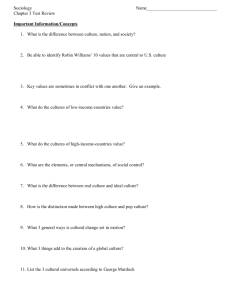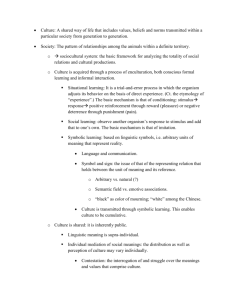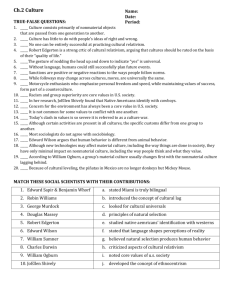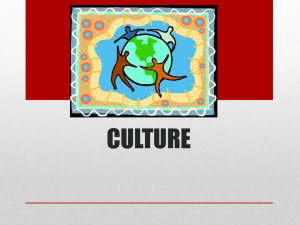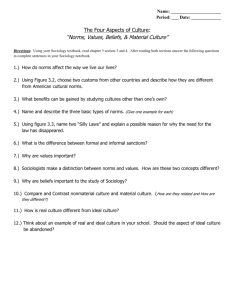Culture - Images
advertisement
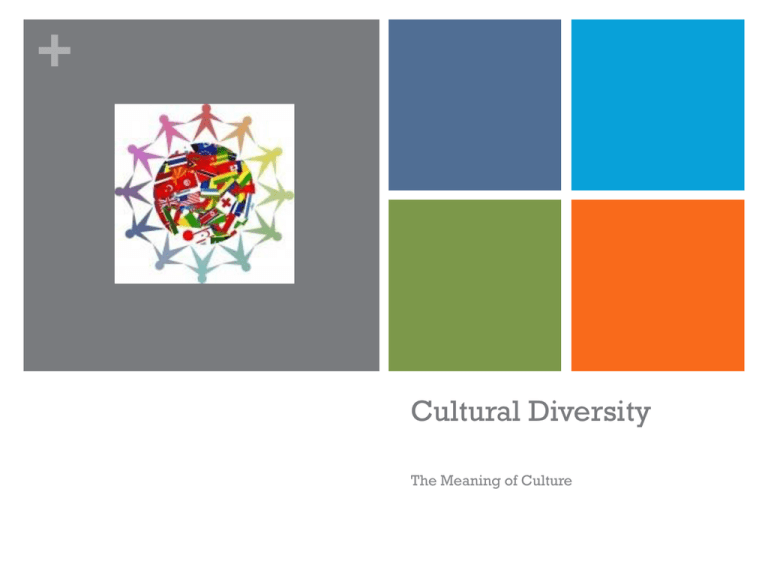
+ Cultural Diversity The Meaning of Culture + What is Culture? Culture consists of all the shared products of human groups Includes: physical objects, beliefs, values, and behaviors Name some aspects of culture: + Material v. Nonmaterial Culture Material culture: physical objects that people create and use Examples: cars, books, buildings, clothing, computers, cooking utensils What are some other examples of material culture? + Material v. Nonmaterial Culture Nonmaterial culture: abstract human creations Examples: beliefs, family patterns, ideas, language, political and economic systems, rules, skills, and work practices What are some other examples of nonmaterial culture? + Material v. Nonmaterial Culture Culture Material Culture: Physical objects people create and use Nonmaterial Culture: Abstract human creation Examples: Examples: + Society v. Culture Society and culture are NOT the same term Society is a group of people who have organized to share a common culture Society consists of people Culture consists of the material and nonmaterial products that people create Culture is a result from society + Components of Culture Elements of culture vary between different societies All cultures have certain basic components: Technology Symbols Language Values Norms + Technology Technology - Combination of physical objects and the rules for using those objects Use of material culture requires knowledge of various skills, which is nonmaterial culture What are some examples of technology in our culture? + Symbols Symbols - Anything that represents something else Any word, gesture, image, sound, physical object, event, or element of the natural world can be a symbol People must recognize that the symbol holds a meaning Very basis of human culture Different cultures have different symbols, but all use them What are some examples of symbols in our society? Do you know any symbols that have a different meaning in other cultures? + Language Language - The organization of written or spoken symbols into a standardized system Express and communicate ideas + Values Values - Shared beliefs about what is good or bad, right or wrong, desirable or undesirable Determine the character of people and the kinds of material and nonmaterial culture they create What are some values of American culture? + Norms Norms - Shared rules of conduct that tell people how to act in specific situations Expectations for behavior, not actual behavior Not all individuals in a society follow norms Some norms are selective – apply to some people, but not others Range from unimportant to extremely important + Norms 2 types of norms: Folkways – norms that describe socially acceptable behavior but do not have great moral significance Common customs of everyday life Minor punishment if not followed Mores – norms with great moral significance Violation of rules endangers society’s well-being & stability Most societies have formalized mores by creating laws – written rules of conduct enacted & enforced by the government + Levels of Culture Culture traits Culture complexes Culture patterns + Culture Traits Simplest level of culture Culture trait - An individual tool, act, or belief that is related to a particular situation or need Example: using a fork, knife, and spoon when eating + Culture Complexes Culture complex – cluster of interrelated culture traits Example: football + Culture Patterns Culture pattern – combination of a number of culture complexes into an interrelated whole Example: American athletic pattern from the separate complexes of individual sports Patterns form important components of society’s culture


